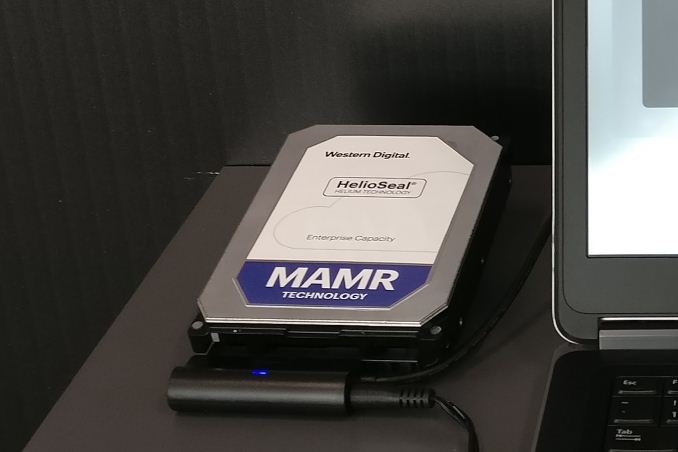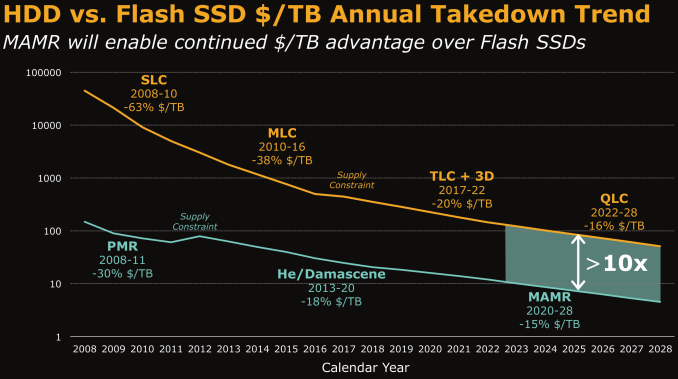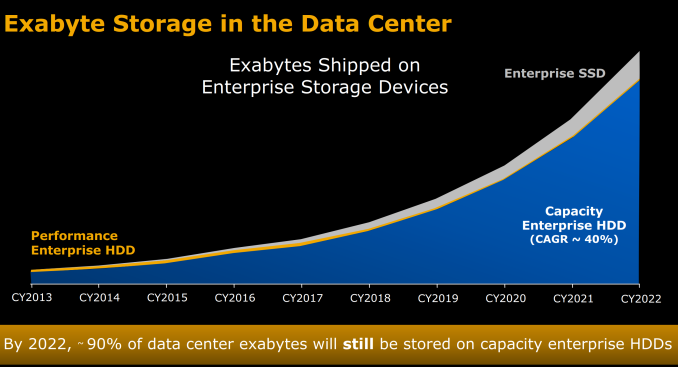Western Digital Stuns Storage Industry with MAMR Breakthrough for Next-Gen HDDs
by Ganesh T S on October 12, 2017 8:00 AM EST
Yesterday, Western Digital announced a breakthrough in microwave-assisted magnetic recording (MAMR) that completely took the storage industry by surprise. The takeaway was that Western Digital would be using MAMR instead of HAMR for driving up hard drive capacities over the next decade. Before going into the specifics, it is beneficial to have some background on the motivation behind MAMR.
Hard drives may be on the way out for client computing systems, but, they will continue to be the storage media of choice for datacenters. The Storage Networking Industry Association has the best resources for identifying trends in the hard drive industry. As recently as last year, heat-assisted magnetic recording (HAMR) was expected to be the technology update responsible for increasing hard drive capacities.

Slide Courtesy: Dr.Ed Grochowski's SNIA 2016 Storage Developer Conference Presentation
'The Magnetic Hard Disk Drive: Today’s Technical Status and Its Future' (Video, PDF)
Mechanical Hard Drives are Here to Stay
One of the common misconceptions amongst readers focused on consumer technology relates to flash / SSDs rendering HDDs obsolete. While using SSDs over HDDs is definitely true in the client computing ecosystem, it is different for bulk storage. Bulk storage in the data center, as well as the consumer market, will continue to rely on mechanical hard drives for the foreseeable future.
The main reason lies in the 'Cost per GB' metric.
Home consumers are currently looking at drives to hold 10 TB+ of data, while datacenters are looking to optimize their 'Total Cost of Ownership' (TCO) by cramming as many petabytes as possible in a single rack. This is particularly prevalant for cold storage and archival purposes, but can also expand to content delivery networks. Western Digital had a couple of slides in their launch presentation yesterday that point towards hard drives continuing to enjoy this advantage, thanks to MAMR being cost-effective.
Despite new HDD technology, advancements in solid state memory technology are running at a faster pace. As a result SSD technology and NAND Flash have ensured that performance enterprise HDDs will make up only a very minor part of the total storage capacity each year in the enterprise segment.
The projections presented by any vendor's internal research team always need to be taken with a grain of salt, but given that SanDisk is now a part of Western Digital the above market share numbers for different storage types seem entirely plausible.
In the next section, we take a look at advancements in hard drive technology over the last couple of decades. This will provide further technical context to the MAMR announcement from Western Digital.












127 Comments
View All Comments
'nar - Friday, October 13, 2017 - link
I usually prefer to pronounce acronyms as the letters are pronounced in their respective words. In this case "UH"-ssisted would lead me to pronounce M"UH"MR. "AYE"ssisted just doesn't sound right. "AH"ssisted is close, but weird if you linger on the "H" too long. Although, I was pronouncing it as "Mammer," like Hammer, as I was reading the article, "EH"ssisted doesn't work.WesternDigital - Friday, October 13, 2017 - link
Hi! Erik from Western Digital here (I manage @WesternDigital on Twitter). HAMR isn't dead, it just isn't economically or technically feasible yet. We talk about why, and why MAMR is what we're working with now, in this article: http://innovation.wdc.com/game-changers/energy-ass...Alexvrb - Saturday, October 14, 2017 - link
Ah yes, but when should we expect HAMAMR drives? I'm looking forward to 100TB 3.5" drives. To uh, archive newsletters, and such. Yeah... that's it.HollyDOL - Saturday, October 14, 2017 - link
That's a lot of past-10pm "fun", even in 4kSamus - Sunday, October 15, 2017 - link
It's great to see representatives of the manufacture monitor and reply to an article with relevant feedback. Just another reason WD is totally killing it. Cheers!Samus - Sunday, October 15, 2017 - link
It isn't dead. Competition is good. It's possible HAMR could have densities well beyond 4Tb/sq in. in which case its expected increased costs, complexities, and possibly reduced reliabilities, might be of benefit to those data centers where storage density is more critical than long-term reliability. Considering HAMR has wear leveling algorithms and will share a lot with NAND in terms of firmware and controller technology, HAMR drives might have a more predictable "expiration" date.But it is clear that WD has made some very good moves. They have always been a strategically successful company in my opinion. Seagate beat them to market in various consumer technologies, but in the corporate and enterprise space, I think their success really began with the Raid Edition drives, near line innovation, and especially the acquisition of Hitachi, which clearly played out well for both companies, and consumers (Hitachi drives were historically more expensive but now that tech is available in mass market WD products)
jospoortvliet - Thursday, October 19, 2017 - link
Then again they shut down their WDLabs team. Seems less than smart to shut shown your innovation and research team to save costs but I don't know exactly what they did perhaps there were similar teams in the company...MajGenRelativity - Thursday, October 12, 2017 - link
Well, this looks quite interesting. Hopefully this will contribute to higher capacity HDDs with a slight speed increasebill.rookard - Thursday, October 12, 2017 - link
40TB on one HDD is more than I have spread out over almost 12 drives at the moment. My worry though is that those 40TB drives are going to be pretty pricey.MajGenRelativity - Thursday, October 12, 2017 - link
They probably will be very pricey, but come down in price over time